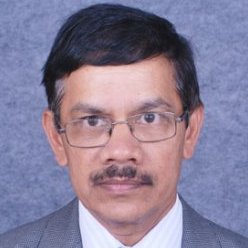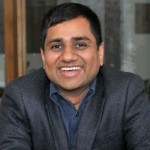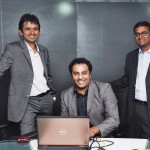Genesis of InstaHealth.
Ramesh Emani Co-Founder & CEO InstaHealth, did his engineering from JNTU and his M.Tech from IIT Kanpur. Insta Health Solutions focusses on Hospital Management and Treatment Management solutions for the Healthcare market in emerging markets of India, Middle East, South East Asia and Africa. He spent close to 25 years at Wipro from 1983 as a part of the first generation of IT people and saw the India story emerge. He was the first sales person for Wipro in the US as a Key Account Manager . Having started the key account of GE, he came back to India as he realized that he can grow the business better by sitting out of India. Ramesh had seen multiple businesses and good sales people in multiple countries and was an integral part of Wipro’s growth upto USD 4 Billions of which he was running USD 1 Billion. He decided to pursue his entrepreneurial dream in the last 10 years of his career and Ramesh left Wipro as the President of the Telecom and Product Engineering division handling around 20,000 people
Choosing the Space
It was tough to do anything while at work and he came out and spent five to six months thinking about the constraints and opportunities. He decided not to do services as that would not be exciting and he had also seen it in his past. He felt India is poised to excel in software products market and wanted to pursue product opportunities. He knew that emerging markets will dominate the next century as growth markets than the US, Europe and wanted to focus on that. Unfortunately, he had no clue on the emerging markets as he had not worked in those but had the DNA to learn new markets as he had done it many times. He met a few people and began talking to them and found out that Healthcare is the best place to enter because
1 This is one of the least automated area
2 They spend the least on IT and
3 There were no big players/brand names in the industry.
Customer Validation
Once he came to a conclusion on what he wanted to do, he went and met 40 to 50 hospitals just to talk to them on what they are doing. He learned their processes and understood their challenges and these discussions convinced him that this was a great market. He also knew that the responses from the same nice people, who did not want to disappoint him, might be different when he goes back with a product and ask them to open the purse. He decided to do an ERP for the healthcare market in june 1 2008.
Sizing the Market
Since he had never worked in HealthCare market, he was nor prepared for the competition. He found that there were lots of software companies providing simplistic VB based systems. Every major city had a local HMS provider. He also found that the hospitals wanted not a simplistic solution but wanted a complex system that will address the entire complex processes. Every system covered 75% of the Hospitals needs but no one covered the last mile of 25%. Ramesh spent the bulk of his time on sales but did not spend much time on the product because he wanted to know what the market wanted and this has helped. He realized that he was on the right path and aligned his product design to focus on the customer’s requirements. Ramesh says that they are very successful today in the Indian market because of the time he spent on sales. He did not worry about the first 2 years that he lost because he knew that they did not have prior experience and they should spend more time mapping the product and the market requirements. The thing that went in their favour was that every other competitor in India was smaller than they were and that gave them lots of time to correct themselves. The initial customers helped them to understand the needs of the market.
Early days of Sales
The initial sales calls were with people they had known in the past but realized that they will soon run out of the list. They wanted an entity that can take them to multiple doctors. Ramesh could not find sales people who had sold HMS as there were no large players from whom he can hire. He explored the Pharma sales reps who had good connects with the doctors. He was lucky to find one sales person who had lots of good connects and he had set up the initial sets of meetings with his prior network. Ramesh constantly travelled between Bangalore and Chennai and kept his market geography in such a way that he can be at the customers place with just an overnight travel. Ramesh personally went for all the sales meetings along with the sales person and pushed the doctors to take the product. This got them the first few sales.
Entering New Markets
After a good number of customers in India, they decided to enter new markets. They felt that the Indian market gave them a good grip on the Product/Market fit but was was not very good from the profitability perspective. As per Ramesh’s earlier vision, he wanted to focus only on developing markets. He found that Middle East will be a nice choice because the market follows western policies and the product had also evolved with high end functionalities to suit the advanced markets. This, Ramesh says, was a good move in increasing their price point and hence the profitability also. He came across a person in an exhibition who did lots of work in HMS in Middle East. They built a good network and Ramesh offered to take the tab on the expenses and took the person to Middle East. Ramesh again had one customer in Kurnool who knew someone in Hyderabad who had some contacts in Dubai. This landed him with meetings with Hospitals and also a good business partner in Middle East.
Differentiators in the market
The team never compromised on the design of SaaS as well as On-Premise. Their pitch to the customers telling them not to worry about the upgrades to suit their changing needs as all of these are free. They also harped on the fact that the hospitals need not have many dependable IT staff and expensive hardware. The final nail on the security of data in the hands of the smaller unknown companies the hospitals have outsourced the HMS to and the guarantee of security and support because they have a name to worry about got them the deals. Ramesh says, they got the deals compared to their competitors because of his background and pedigree.
What worked for them in Marketing
They had a large sales team that went and met the customers to sell. They decided to spend some time in Marketing also because of the large and rapid reach . They spent lots of time coming up with a good website as that was the invisible salesman for them. They differentiated by having lots of useful information on their website compared to their competitors who had four or five pages only. This worked in their favor because their customers began believing them by seeing so much of public information of the product, the screen shots and the benefits. The team also spent quite a bit of time on SEO. These two things increased the number of In-Bound enquiries by 10 times which became a great add-on to the Outbound Sales initiatives. They also paid Retainer ship to a marketing company to continue to write articles on the website. Ramesh says that these were the simple marketing initiatives that he undertook. Additionally, the satisfied customers word of mouth references also helped him get new customers.
Ramesh’s positioning
Ramesh had never worked in the SME market as he always worked with F100’s and equivalents. Ramesh says that he found out that both ends of the world works in their own ecosystems (both SME as well as the larger enterprises). A startup, in their early stage should position themselves as a small company when they target the smaller companies because this will keep you in their size. Having worked with large companies and having good understanding of what large enterprises want, has helped him in position Insta as a small company with big growth potential and service capability.
First Customer Acquisition (India)
Deepam Hospitals (Chennai) was his first customer. This was in early 2009 – within one year of launching the product. When they went in for the sales call, Ramesh ensured that they had a proper office address, business card, brochures and ensured that they did not look or behave like a startup. They were able to demonstrate the product on any laptop. They spoke about the background of the founding team and convinced the hospitals that they will be able to handle any issues. Ramesh says that a startup should not keep saying that they have just begun because customers in a B2B situation do not necessarily bother about it. Ramesh says that Customers will buy from a supplier as long as they give value and no one cares about the size of the company. Ramesh says that he projected himself as a professional company but accepted that he was not big.
The product was also in the early stage and the prospect began pointing out gaps. Ramesh and team went back to their office and developed the functionalities. They came back and demonstrated the changes. A few gaps were identified this time and Ramesh came back with the changes. This went on for a few times. Ramesh’s approach was very systematic in his sales because of his past and this was non-existent in the healthcare industry as the hospitals were not used to vendors working so diligently and so professionally. Ramesh smelled a deal and were after them, wooed them with persistence, waited till 9:00 PM to give demos and showed sincerity. He met them almost 25 times over six months to close the first deal.
First Customer Acquisition (Middle East)
Ramesh recalls that he was lucky for some reason on the Middle East market when he looks at it today. There were a few changes happening in the regulatory framework of Insurance and there was one hospital which was trying to adopt the new Insurance framework. Coincidentally, the product was a perfect fit for the new requirements. Ramesh sent his CTO to Middle East who spent a week and give multiple demos with immediate customization. The client was impressed with the commitment of a senior person like the CTO coming in, understanding their needs, speaking healthcare terminologies, astute in technology and showing functional demos. This got them the P.O for a group of 6 hospitals. Ramesh always smelt out the prospects who can buy and capitalized on the first opportunity as he knew that he will not have time or money to deal with multiple prospects to close the deals. So they capitalised the first opportunity in ME and they invested lots of time and efforts upfront which got him the entry and a referencable customer in that market.
One thing he could have done better.
Ramesh says that he would have done better if he had read Steve Blank’s blog on MVP. He spent too much of time on sales where he should have spent good amount of time in developing the MVP version. He feels that he should have given the market just what they wanted nothing more nothing less. Based on initial sales success he rapidly increased sales team to 15 people and wasted lot of money and time, when he did not have the product or marketing to drive so many sales people. He closed all those offices and got back to just 3 sales people and spent time on web site and making the product better. That was when the sales started giving results.
Ramesh’s Advice to early stage entrepreneurs
Keep dreaming, but you need to be grounded. It is worth it but you will go through a huge roller coaster ride in order to succeed.
InstaHealth today
They have around 80 employees, 180 hospitals serving over 400 locations in 11 countries. They raised Funding in less than one year in April 2009 with a VC. They are ranked among the top 10 HealthCare players by the CIO magazine






